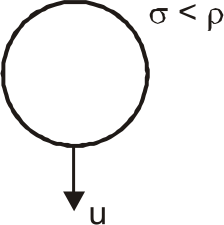The terminal velocity of a sphere of radius R, falling in a viscous fluid, is proportional to
R
1R
R2
1R2
The correct Answer is:C
To determine how the terminal velocity V of a sphere of radius R falling in a viscous fluid is proportional to the radius, we can use the formula for terminal velocity.
1. Understand the Formula for Terminal Velocity:
The terminal velocity V of a sphere falling through a viscous fluid is given by the equation:
V=29(R2)(ρ−σ)gη
where:
- R is the radius of the sphere,
- ρ is the density of the sphere,
- σ is the density of the fluid,
- g is the acceleration due to gravity,
- η is the viscosity of the fluid.
2. Identify the Proportionality:
From the formula, we can see that the terminal velocity V is directly proportional to R2 (the square of the radius). This means that as the radius increases, the terminal velocity increases with the square of that increase.
3. Conclusion:
Therefore, we can conclude that the terminal velocity V is proportional to R2.
Final Answer:
The terminal velocity of a sphere of radius R falling in a viscous fluid is proportional to R2.
The terminal velocity V of a sphere falling through a viscous fluid is given by the equation:
V=29(R2)(ρ−σ)gη
where:
- R is the radius of the sphere,
- ρ is the density of the sphere,
- σ is the density of the fluid,
- g is the acceleration due to gravity,
- η is the viscosity of the fluid.
From the formula, we can see that the terminal velocity V is directly proportional to R2 (the square of the radius). This means that as the radius increases, the terminal velocity increases with the square of that increase.
Therefore, we can conclude that the terminal velocity V is proportional to R2.
The terminal velocity of a sphere of radius R falling in a viscous fluid is proportional to R2.
Topper's Solved these Questions
- MECHANICAL PROPERTIES OF FLUIDSBook:AAKASH INSTITUTE ENGLISHChapter:MECHANICAL PROPERTIES OF FLUIDSExercise:SECTION - B
Explore 23 Videos
- MECHANICAL PROPERTIES OF FLUIDSBook:AAKASH INSTITUTE ENGLISHChapter:MECHANICAL PROPERTIES OF FLUIDSExercise:SECTION - C
Explore 15 Videos
- MECHANICAL PROPERTIES OF FLUIDSBook:AAKASH INSTITUTE ENGLISHChapter:MECHANICAL PROPERTIES OF FLUIDSExercise:TRY YOURSELF
Explore 41 Videos
- MAGNETISM AND MATTER Book:AAKASH INSTITUTE ENGLISHChapter:MAGNETISM AND MATTER Exercise:ASSIGNMENT (SECTION D)
Explore 26 Videos
- MECHANICAL PROPERTIES OF SOLIDSBook:AAKASH INSTITUTE ENGLISHChapter:MECHANICAL PROPERTIES OF SOLIDSExercise:Assignment(Section-D)
Explore 14 Videos
Similar Questions
Knowledge Check
The terminal velocity of small sized spherical body of radius r falling veertically in a viscous liquid is given by a following proportionality
A1r2B1rCrDr2After terminal velocity is reached the acceleration of a body falling through a viscous fluid is:
AzeroBequal to gCless than gDmore than gAfter terminal velocity is reached the acceleration of a body falling through a viscous fluid is:
AzeroBequal to gCless than gDmore than g
Choose the correct option:
When a sphere falling in a viscous fluid attains terminal velocity, then
View SolutionA sphere of density ρ falls vertically downward through a fluid of density σ. At a certain instant its velocity is u. The terminal velocity of the sphere is u0. Assuming that stokes’s law for viscous drag is applicable, the instantaneous acceleration of the sphere is found to be β(1−σρ)(1−uu0). here β is in an integer. find β.

View SolutionA small sphere of volume V falling in a viscous fluid acquires a terminal velocity vt. The terminal velocity of a sphere of volume 8V of the same material and falling in the same fluid will be :
View SolutionA sphere of radius R is gently dropped into liquid of viscosity η in a vertical uniform tube. It attains a terminal velocity v. Another sphere of radius 2R when dropped into the same liquid, will attain its teriminal velocity.
View SolutionSpherical balls of radius R are falling in a viscous fluid of velocity v .The retarding viscous force acting on the spherical ball is
View Solution